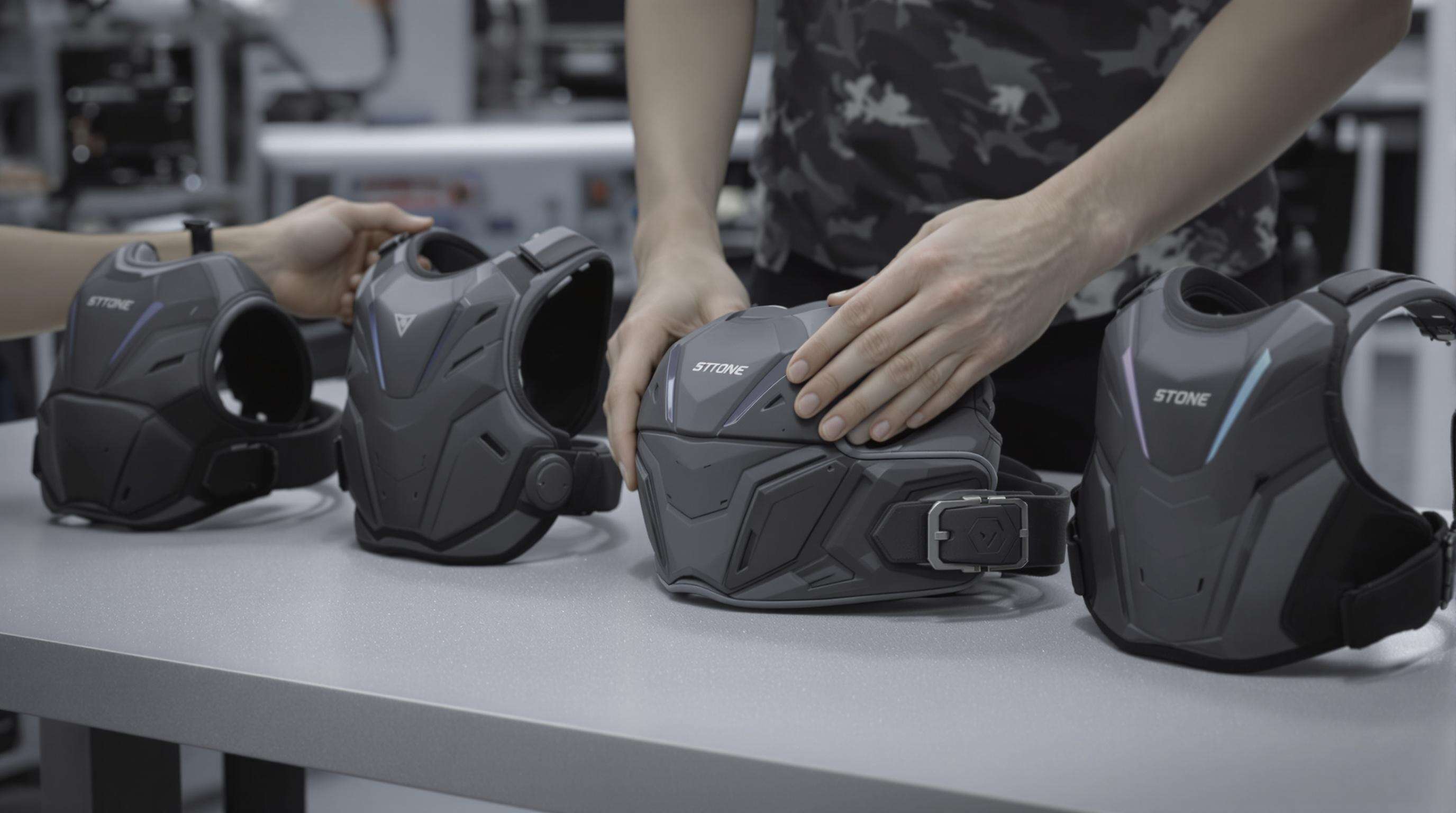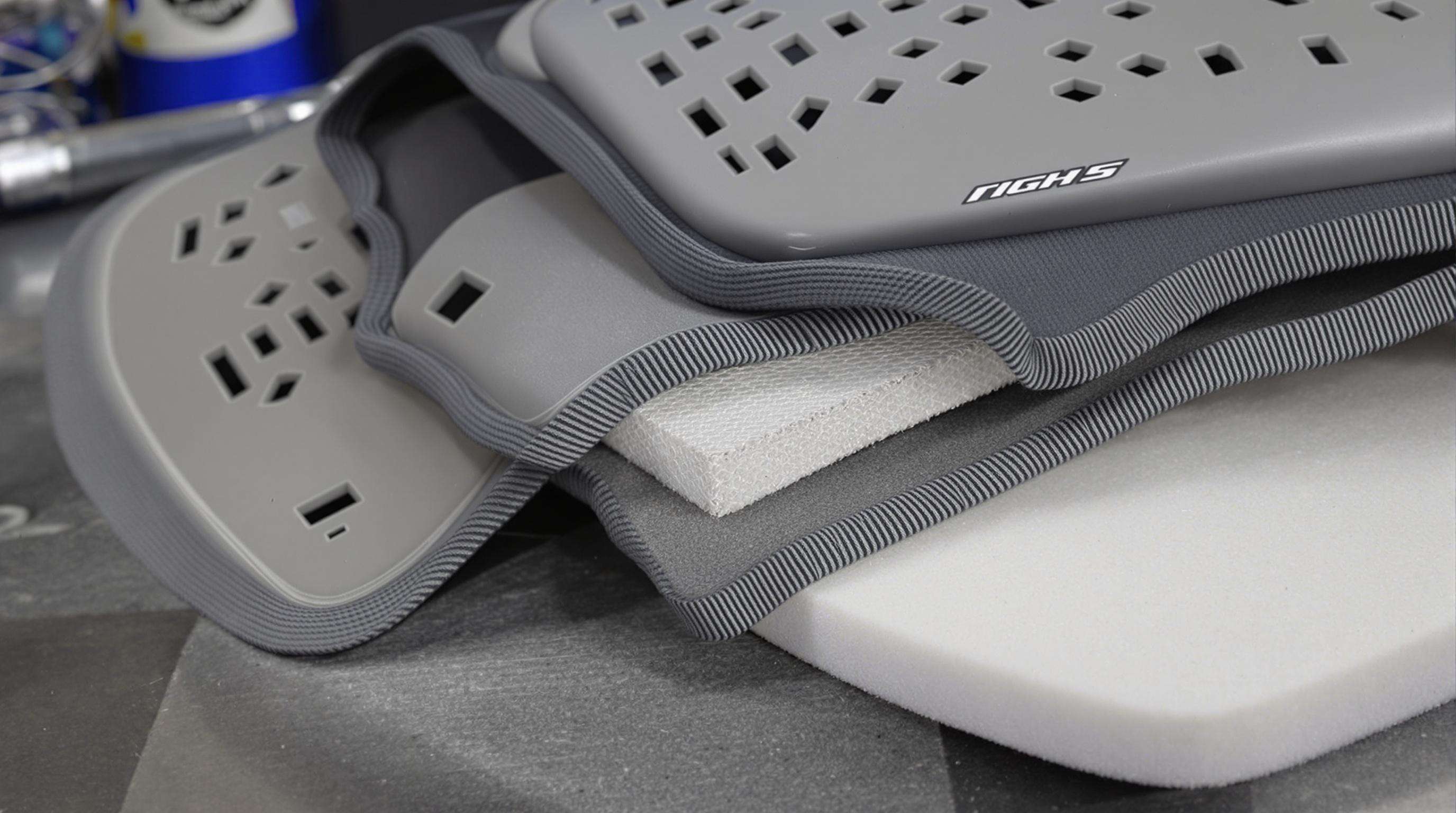توضح المعيار EN1621-2:2014 مستويين من الشهادات لواقي الظهر للدراجات النارية، ويتم تحديد المستويات حسب الكمية وقوة الضرر التي يمكن امتصاصها. يحد مستوى 1 من القوة المنقولة إلى أقل من 18 كيلو نيوتن (kN) وفي المستوى 2 إلى 9 كيلو نيوتن - أي ما يعادل امتصاصًا إضافيًا للطاقة بنسبة 50%. وقد تم تأكيد هذه الحدود من خلال اختبارات سقوط عمودية منتظمة على نماذج أرضية تمثل اصطدامات بسرعة 27 ميل في الساعة (43.5 كم/ساعة). ويحقق المصنعون هذا الامتثال عبر استخدام هياكل رغوية مسامية أو بوليمرات تفاعلية تكون متوقعة في الانضغاط.
تشمل علامات الشهادة الرئيسية:
تتضمن homologation EN1621-2:2014 اختبار الطرف الثالث على خمس مراحل؛ فحوصات على المادة، وتقييم أداء التأثير، واختبارات تُجرى فيها دورات حرارية تتراوح بين -10 إلى +40 درجة مئوية، واختبارات مقاومة البلى واختبارات دوام الملصقات. تقوم جهات مثل SATRA بفحص 12 حافظة متطابقة لاختبار توافر الدُفعات، ورغم أن القوة الأعلى تعني حماية أفضل، إلا أنه إذا تخطى أحد الحواجز حدود القوة في تلك الدفعة، يُرفض المجموعة بأكملها. نحن نمنح منتجات معتمدة بالمواصفات المناسبة صلاحية شهادة مدتها خمس سنوات، كما أوضح قائلاً إن إعادة الاختبار ضرورية بعد ذلك. وأفادت تقارير اختبارات حديثة من الاتحاد الأوروبي بأن 92% من حواجز الظهر ذات العلامة CE تظل مطابقة طوال عمر المنتج عند استخدامها وفق الإرشادات المهنية.

لقد قطعت واقيات الظهر شوطًا طويلاً منذ ظهور واقيات الظهر الحديثة للموتسيكلات التي يُصنع بعضها من مواد تكنولوجية متقدمة، ويتم تصميمها باستخدام هندسة متطورة لتساعدك على الحفاظ على المرونة مع توفير درجة جيدة من الحماية ضد الصدمات. لا تزال الشهادة CE من المستوى 2 وفقًا للمعيار EN1621-2:2014 هي المقياس المعتمد، حيث يسمح للواقيات بأن تنقل ما لا يزيد عن 9 كيلو نيوتن في حالة حدوث اصطدام. أما أحدث التقنيات اليوم فتقدم نفس مستوى الحماية بال combination مع حلول لمقاومة القوى متعددة الاتجاهات أو التكيف مع تشريح الجسم.
يعتمد هذا العلم على البوليمرات اللزجة اللزجة، التي تظل مرنة في ظل ظروف الحركة المعتادة، ولكنها تصلب في غضون بضع مئات من الميللي ثانية من الاصطدام. أثبتت الاختبارات بشكل مستقل أن الأنظمة يمكن أن تقلل من القوة المنقولة إلى 5.6kN 38٪ أقل من حد CP Level 2 مع الحفاظ على بنية رقيقة بشكل مثير للإعجاب 12 ملم لتحسين تشتت الطاقة. كما أن بنية الخلية المفتوحة للرغوة تعزز تدفق الهواء مقابل لوحات الدروع الصلبة.
توفر الأغطية الواقية المقسمة مع مفصلات دقيقة حركة تتناسب مع حركة الجسم. وفي حالة حدوث اصطدام، تُثبّت المفصلات المسننة القطع في مكانها لتشكّل درعاً متيناً بحيث يتم توزيع قوى التأثير على مساحة أكبر بنسبة تصل إلى 40%. ويحقق هذا الجهاز الوقائي ثنائي المراحل معايير حماية CE مستوى 2 دون التضحية بمدى الحركة في الكتفين.
من خلال طبقات من البولي كربونيت المائل وقواعد رغوية امتصاص الصدمات (EVA)، يقوم هذا النظام بإعادة توجيه قوى الاصطدام بعيدًا عن الأعضاء الحيوية. توفر конструкция ذات 7 مناطق صلابة مخصصة عبر مختلف مناطق العمود الفقري، وقد أظهرت في المحاكاة المخبرية المتحكّم بها حماية أفضل بنسبة 22% ضد التأثير الجانبي مقارنةً بحلول الدروع ذات الكثافة الواحدة.

المرونة والتهوية الفعالة ونسبة الوزن إلى الحماية هي مفاتيح رئيسية في واقيات الظهر الخاصة بالدراجات النارية. كل هذه العوامل معًا تحدد ما إذا كان السائق يستخدم معدات الحماية لديه أثناء تنفيذ حركات بهلوانية ديناميكية. يدمج المصنعون هذه الخصائص مع متطلبات الشهادة الأوروبية (EN1621-2:2014) لإنتاج معدات تقلل من خطر الإصابة مع السماح بالمرونة.
يضم التصميم الحالي للكثير من واقيات الظهر مواداً بوليمرية مركبة مع طبقات من مادة البولي يوريثين الحرارية (TPU) تسمح بحركة الجذع عبر 270 درجة. وتم تصميم هذه المرونة بحيث تقاوم التصاميم ذات الألواح الصلبة التي قد تعيق دوران كتفك أثناء المناورات أو في وضعيات القيادة السريعة. وقد اكتشفت دراسة نشرها مجلة العلوم والطب في الرياضة لعام 2019 أن هياكل الرغوة عالية التقنية تقوم بتخميد الصدمات القصوى بنسبة 34٪، وتبقى أكثر مرونة بنسبة 72٪ مقارنة بالتصاميم التقليدية ذات القشرة الصلبة.
تزيد طبقات الهياكل السداسية المثقوبة وشبكة الفواصل ذات الخصائص الطارد للماء من تبخر العرق بنسبة تصل إلى 40% مقارنة بمواد التبطين التقليدية. تعمل القنوات المُوجهة للهواء والموضعية بدقة على اتجاهات الجسم البشري لضمان تبريد الحمل الحراري الأمثل أثناء وجودك في حركة مرور بطيئة داخل المدينة. تؤدي هذه الأنظمة إلى خفض درجة حرارة الجسم الأساسية بمقدار 3.8-4.7°ف (2-3°م) في ظل ظروف تصل إلى أكثر من 30°م، وهي قيمة يُعتبر أنها تمثل عتبة الراحة المهمة في علم وظائف الأعضاء الحرارية.
تقلل هياكل الشبكات البولي أميدية المعززة بالكربون والمقطوعة بالليزر من وزن الحمايات لتتراوح بين 450–700 غرام مع الالتزام بمستويات الصدمة المنصوص عليها في معيار EN1621-2. يتم ذلك من خلال استخدام كثافات مختلفة، مثل espumas خفيفة للغاية (0.18 غ/سم³) للمناطق قليلة الخطورة، وأسطح مركبة تمتص الطاقة (0.45 غ/سم³) في المناطق الرئيسية من العمود الفقري. كما أظهرت ورقة نشرت عام 2020 في مجلة التصنيع الإضافي والطباعة ثلاثية الأبعاد أن تحسين التخطيط الطبولوجي باستخدام الخوارزميات يقلل متطلبات المواد بنسبة 22% ويزيد مقاومة الضغط.
تُركز واقيات الظهر المعتمدة من CE والمخصصة لسائقي الدراجات النارية اليوم على عوامل الإنسان، حيث تُعد الأنظمة القابلة للضبط في الأحزمة ميزة أساسية، والسبب هو أن سائقي الدراجات النارية يختلفون في الأحجام والأجسام. وتشمل الأنظمة المودولية للأربطة 8 إلى 12 نقطة قابلة للتعديل لتوفير مقاس مريح ومضمون على الكتفين والخصر ومنع أي حركة للجسم أثناء المناورات العدوانية. وبحسب دراسة أُجريت في أمريكا الشمالية عام 2025 حول معدات الأمان، يعتقد 78٪ من السائقين أن الإعداد القابل للتعديل مهم للغاية للاستخدام المريح على المدى الطويل. وعادةً ما تحتوي هذه الأنظمة على أنظمة إفراج سريع بدون أدوات، مما يعني تعديلًا فوريًا دون الحاجة إلى أدوات، ولكن دون التأثير على تصنيف CE.
تقلل الإسفنجات المُخصصة لامتصاص الصدمات بشكل استراتيجي من نقاط الضغط المؤلمة بنسبة 63٪ من الركاب في ظروف العمل الإضافي. توفر المناطق المتعددة الكثافة دعماً أكثر صلابة من العمود الفقري حتى الحواف، مما يحقق توازناً بين امتصاص التأثيرات ومرونة مريحة. كما أن الثقوب الموجودة في البنية المُسجلة ببراءة اختراع للدرع تزيد من نفاذ الهواء بنسبة تصل إلى 40٪ مقارنةً بواقي الظهر الأخرى ذات الثقوب، مع الحفاظ على نفس مستوى أداء امتصاص الصدمات مقارنةً بالواقيات غير المثقوبة كما أظهرته دراسات و recents ergonomics حديثة. بالإضافة إلى ذلك، تساهم البطانات التي تمتص الرطوبة في تعزيز هذه العناصر لتقليل الشعور بالحرارة أثناء رحلات المدينة أو الرحلات الطويلة إلى المناطق النائية.
ظروف القيادة تحدد أولويات تصميم واقي الظهر. حيث تركز نماذج الدراجات الوعرة على أقصى تغطية وامتصاص للصدمات، بينما تتوازن واقيات المدينة بين شكلها الرفيع والراحة المستمرة.
واقيات الظهر الخاصة بالطرق الوعرة، وواقيات الظهر للحوامل، والتي تحتوي غالبًا على حزام دعم مدمج يساعد في الحفاظ على وضعية الجلوس بعد الولادة، بالإضافة إلى الحماية أثناء الرضاعة. إن تصميمها بقشرة صلبة يوفر دعمًا ممتازًا حول العمود الفقري، مما يتحمل تأثيرات الطاقة العالية التي تنتج عادةً عن الحوادث على الطرق الوعرة. أما الإصدارات الحضرية فتستخدم طبقات رقيقة ومثقوبة (≤25 مم) لضمان تهوية أفضل أثناء التنقل، مع ألواح مفصلية تتماشى بدقة مع العمود الفقري. وتساعد الإضافات من وسادة إضافية أسفل الظهر في النسخ الموجهة للمدن على التحمل لفترات أطول دون الشعور بألم، مع الحفاظ على شكل منخفض تحت السترات الشتوية.
تظهر في السوق تقنيات جديدة لحماية الظهر تجمع بين أبحاث علم الحركة الحيوية والمواد الذكية، مثل نظام MIPS (نظام حماية التأثير متعدد الاتجاهات) وتقنية Kineticore. يستخدم نظام MIPS بطانة منزلقة تقلل القوى الدورانية بنسبة 30-40% أثناء التأثيرات المائلة (معهد المعدات الأمنية 2023)، بينما تستخدم Kineticore وسادات ماصة للصدمات سداسية الشكل توزع الطاقة عبر عدة مستويات. كما أصبح من الممكن الآن دمج هذه التقنيات مع واقيات مدعمة بالذكاء الاصطناعي يمكنها تحديد التأثير في الوقت الفعلي وخوارزميات تكيفية تضبط مستوى الحماية بناءً على شدة الرحلة. إن الجمع بين طبقات الحماية الميكانيكية والرقمية سيشكل مستقبل السلامة في رياضة ركوب الدراجات النارية.
المستويات الرئيسية لشهادة CE لواقيات الظهر الخاصة بالدراجات النارية هي المستوى 1 والمستوى 2. يحدد المستوى 1 القوة المنقولة بأقل من 18 كيلو نيوتن، بينما يحسن المستوى 2 امتصاص الطاقة بحد أقصى 9 كيلو نيوتن.
يجب إعادة اختبار واقيات الظهر للدراجات النارية لضمان الامتثال لمعايير CE كل خمس سنوات لضمان الحفاظ على خصائصها الوقائية طوال عمرها عند الاستخدام الصحيح لها.
توفر تقنيات الحماية من التأثير المتقدمة فوائد مثل تقليل القوة المنقولة، وزيادة المرونة، وتحسين تهوية الهواء، وتصميمات مريحة تتناسب مع تكوين الجسم لتقديم راحة وحماية أفضل.
 أخبار ساخنة
أخبار ساخنة2025-12-08
2025-09-15
2024-12-30
2024-12-23
2024-12-09
2024-12-02